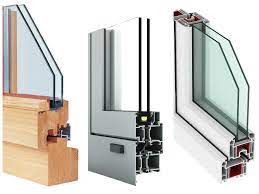When it comes to European windows, the material you choose plays a significant role in the overall performance, aesthetics, and durability of your windows. Aluminum, wood, and vinyl (uPVC) are the most common materials used for European window frames and each with its unique set of advantages and drawbacks. In this article, we’ll compare these three popular materials, helping you make an informed decision for your window replacement or new construction project.
In this article, we’ll compare these three popular materials, helping you make an informed decision for your window replacement or new construction project.
Aluminum European Windows:
Advantages:
- Durability: Aluminum is highly resistant to weathering, corrosion, and warping, ensuring long-lasting performance.
- Slim Profiles: Due to its strength, aluminum allows for slim profiles, which creates a sleek, modern appearance and maximizes the glass area for improved views.
- Low Maintenance: Aluminum windows require minimal upkeep and can be easily cleaned with a mild detergent and water.
- Eco-friendly: Aluminum is recyclable and can be repurposed multiple times without losing its quality.
Disadvantages:
- Thermal Performance: Although thermally broken aluminum windows have improved insulation, they may not be as energy-efficient as wood or uPVC options.
- Cost: Aluminum windows tend to be more expensive than uPVC windows.
Wood European Windows:
Advantages:
- Aesthetics: Wood windows offer a warm, natural, and timeless appeal that can enhance a home’s character.
- Insulation: Wood is a natural insulator, providing excellent thermal and sound insulation.
- Customization: Wood windows can be stained or painted in various colors and finishes to match your home’s design.
Disadvantages:
- Maintenance: Wood windows require regular maintenance, such as painting or staining, to prevent rot, decay, and warping.
- Cost: Wood windows are generally more expensive than uPVC windows and may require more frequent maintenance.
Vinyl (uPVC) European Windows:
Advantages:
- Energy Efficiency: uPVC windows offer excellent insulation properties, contributing to reduced energy consumption and lower utility bills.
- Low Maintenance: Unlike wood, uPVC windows do not require painting or staining and can be easily cleaned with soap and water.
- Cost-effective: uPVC windows are typically more affordable than aluminum or wood options, making them an attractive choice for budget-conscious homeowners.
Disadvantages:
- Appearance: While uPVC windows have improved in design over the years, they may not offer the same level of aesthetic appeal as wood or aluminum windows.
- Environmental Impact: uPVC is not as eco-friendly as aluminum or sustainably harvested wood, as it is not biodegradable and can release toxic chemicals when burned.
To conclude :
When selecting the ideal material for your European windows it is important to consider factors such as aesthetics, maintenance requirements, energy efficiency and cost. Aluminum, wood, and vinyl (uPVC) each have their unique advantages and disadvantages, so weigh your priorities and preferences to make the best choice for your home. By selecting the right material you can enhance your home’s appearance, improve its energy efficiency and ensure lasting durability for your European windows.
